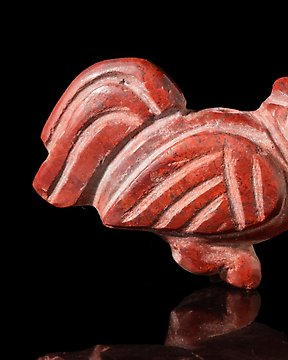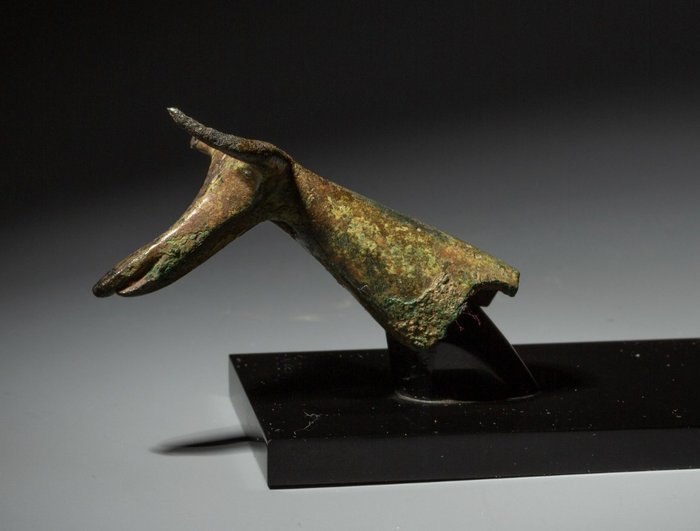
Nabij Oostelijk Stenen Haan Amulet (Zonder Minimumprijs)
Nr. 82704249

Nr. 82704249

Bull Head.
Nuragic, 1st millennium BC.
Bronze
7 cm length.
PROVENANCE: Private collection of gallery owner Claude Bernard (1929-2022), Paris. Founder of the Claude Bernard gallery in Paris, he has represented as a dealer from Alberto Giacometti to David Hockney, passing through Balthus, Francis Bacon, Lucian Freud and Zoran Music, during the last sixty-five years he has represented the greatest artists of the 20th and 21st centuries.
DOCUMENTS: Including export license from the Ministry of Culture in Spain.
CONDITION: Good condition.
DESCRIPTION:
Nuragic civilization is undoubtedly the most important autonomous cultural expression about ancient
Sardinia, but it cannot be separated from the expressions preceding and following it.
The Nuragic civilization is autochthonous, namely an indigenous civilization formed in Sardinia by
populations rooted on the island for thousands of years. It is based on the experiences of immediately
preceding pre-Nuragic cultures. Since Sardinia is a large island, it was able to accommodate and
sustain for at least 5000 years, sometimes in close contact with the surrounding world and at others
in conditions of relative isolation, the development of prehistoric Neolithic people dedicated to
agriculture and farming and those of the Copper Age and early Bronze Age (about 7000-1600 BC).
As can be seen from the results of the latest archaeological research, the Nuragic civilization has
taken hold during the middle and late Bronze Age (about 1600-930 BC) and in the early Iron Age
(about 930-730 BC).
In ancient times the Bronze Age was the age of heroes, capable of doing great actions for good or
evil, powerful kings, brave and cunning warriors, ingenious builders. The atmosphere of those bygone
times is still powerfully evoked by the Iliad and the Odyssey, poems written a few centuries later but
deriving from oral tales which circulated in Greece during the Bronze Age. Most likely, Bronze Age
Sardinia had experienced a non-urban, monarchic, yet rural and tribal, society, though still organized
and lively, capable of transforming the territory, exploiting resources and making contact with the
surrounding world.
The Iron Age is instead the age of the historical peoples, which were formed in different regions of
Italy and in the islands identifying themselves with names which are still known regional
communities. Besides, in the west, the Iron Age is the age of the great navigators, of colonization, of
the first cities and early states.
The development of the Nuragic civilization could be divided into four major phases. The first is the
phase of the archaic nuraghi (Middle Bronze 2: about 1600-1500 BC); the second is the phase of the
classical nuraghi (Middle Bronze 3 and Late Bronze: about 1500-1200 BC); the third is the processing
phase (Late Bronze: about 1200-930 BC); the fourth is the crisis and dissolution phase (Early Iron
Age: about 930-730 BC). The scholar Giovanni Lilliu had also distinguished a fifth phase, which is
now however no longer considered to be Nuragic in that since the end of the 8th cent. BC the peoples
of Sardinia rapidly abandoned the Nuragic cultural heritage and blended with the descendants of
Phoenician traders who had settled for quite some time on the island, mostly along the coast.
Theories seeing a sharp clash of ethnic and cultural blocks, resolved with arms to the advantage of
lawless immigrants and to the detriment of the unfortunate Nuragic inhabitants, are now completely
outdated. Rather, it should be admitted that the Phoenicians, a people with extraordinary innovation
skills in the field of social organization, have increasingly taken advantage of every opportunity
offered them by the collapse of the Nuragic world, whose demise had started a long time before and
soon reached a rapid conclusion.
Notes:
- The piece includes authenticity certificate.
- The piece includes Spanish Export License.
- The seller guarantees that he acquired this piece according to all national and international laws related to the ownership of cultural property. Provenance statement seen by Catawiki.
Zo koop je op Catawiki
1. Ontdek iets bijzonders
2. Plaats het hoogste bod
3. Veilig betalen